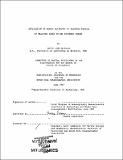| dc.contributor.advisor | Barry Parsons. | en_US |
| dc.contributor.author | Driscoll, Mavis Lynn | en_US |
| dc.contributor.other | Woods Hole Oceanographic Institution. | en_US |
| dc.date.accessioned | 2012-02-24T16:28:01Z | |
| dc.date.available | 2012-02-24T16:28:01Z | |
| dc.date.copyright | 1987 | en_US |
| dc.date.issued | 1987 | en_US |
| dc.identifier.uri | http://hdl.handle.net/1721.1/69180 | |
| dc.description | Thesis (Ph. D.)--Joint Program in Oceanography (Massachusetts Institute of Technology, Dept. of Earth, Atmospheric, and Planetary Sciences; and the Woods Hole Oceanographic Institution), 1987. | en_US |
| dc.description | Vita. | en_US |
| dc.description | Includes bibliographical references. | en_US |
| dc.description.abstract | Gravity derived from Seasat altimetry has provided a means of estimating seafloor topography and its compensation, which in turn can be used to understand the evolution of oceanic lithosphere. In the first study, the correlation between the geoid, deflection of the vertical, and seafloor topography is investigated along a section of the Southwest Indian Ridge. Geoid anomalies computed from a simple thermal model fairly accurately predict the intermediate-wavelength anomalies across the fracture zones. The shorter wavelength anomalies are consistent with those calculated from topography using elastic plate compensation. The combined effect of the thermal offset and seafloor topography produces an anomaly which has a small-amplitude, short-wavelength depression directly over the fracture zone valley. Pronounced lineations in the horizontal geoid gradient do not coincide with the valley but have trends parallel to the fracture zones. In the second study, fracture zones along the Southwest Indian Ridge are identified using altimeter profiles and bathymetry. Finite poles of rotation are determined from the fracture zone locations and magnetic anomaly lineations for anomalies 6 (20 Ma), 13 (37 Ma), and 20 (45 Ma). The new poles are in general agreement with previously published poles and describe a fairly consistent direction of relative motion between Africa and Antarctica for the past 45 Myr. A present-day pole of rotation calculated from transform fault azimuths determined primarily from their geoid anomalies, agrees with published poles based on bathymetric data. In the third study, the rate of change of the geoid with age has been estimated as a function of age from geoid offsets across the Eltanin and Udintsev fracture zones and used to constrain thermal models of lithospheric cooling. Observed trends in the geoid slope versus age plots are similar on both branches of the Eltanin and the east limb of the Udintsev fracture zone. The similarity in trends argues against the effects of isolated thermal or bathymetric anomalies and appears instead to reflect a general feature of the geoid-slope versus average age relationship across fracture zones. Although the thermal plate cooling model is successful in predicting both seafloor depths and heat flow values out to ages of at least 80 m.y. B.P., it cannot explain the observed geoid slope values for these two fracture zones. It is not clear at this point whether this is due to inadequacies in the cooling model or to peculiarities in fracture zone evolution. | en_US |
| dc.description.statementofresponsibility | by Mavis Lynn Driscoll. | en_US |
| dc.format.extent | 165 leaves (some folded) | en_US |
| dc.language.iso | eng | en_US |
| dc.publisher | Massachusetts Institute of Technology | en_US |
| dc.rights | M.I.T. theses are protected by
copyright. They may be viewed from this source for any purpose, but
reproduction or distribution in any format is prohibited without written
permission. See provided URL for inquiries about permission. | en_US |
| dc.rights.uri | http://dspace.mit.edu/handle/1721.1/7582 | en_US |
| dc.subject | Joint Program in Oceanography. | en_US |
| dc.subject | Earth, Atmospheric, and Planetary Sciences. | en_US |
| dc.subject | Woods Hole Oceanographic Institution. | en_US |
| dc.subject.lcsh | Isostasy | en_US |
| dc.subject.lcsh | Marine geophysics | en_US |
| dc.title | Application of Seasat altimetry to tectonic studies of fracture zones in the Southern oceans | en_US |
| dc.title.alternative | Seasat altimetry to tectonic studies of fracture zones in the Southern oceans, Application of | en_US |
| dc.type | Thesis | en_US |
| dc.description.degree | Ph.D. | en_US |
| dc.contributor.department | Joint Program in Oceanography | en_US |
| dc.contributor.department | Woods Hole Oceanographic Institution | en_US |
| dc.contributor.department | Massachusetts Institute of Technology. Department of Earth, Atmospheric, and Planetary Sciences | |
| dc.identifier.oclc | 17914520 | en_US |

